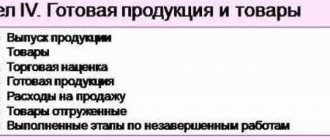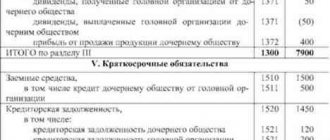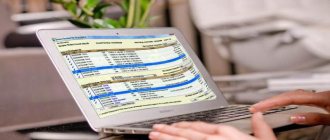The concepts of “operating income and expenses” are used in financial analysis and in international financial reporting standards. These terms are not currently used in domestic accounting and reporting standards.
In a general sense, operating activities include all business activities of a company related to the use of its assets and aimed at implementing the functions for which it was created.
Within the framework of Russian legislation, there is a concept of ordinary activities (in the terminology of PBU 9/99 “Income of the organization”), the volume of which should be at least 70% of total revenue, and in the unified state register of legal entities this direction is noted as the main one.
What is operating profit
By operating profit, economists understand the profit of an organization that is generated in the process of the company’s main activity (selling goods, performing work, providing services). Operating profit is an indicator that is calculated by subtracting from gross profit those expenses that are usually classified as operating, that is:
- aimed at the purchase of raw materials, materials, components;
- aimed at paying for electricity and equipment repairs;
- represented by management costs.
At the same time, when calculating operating profit, interest payable, as well as other income and expenses of the company (which may be associated, for example, with investment activities) are not considered.
A common formula for calculating operating profit looks like this:
OP = VP – KR – NR,
Where:
OP - operating profit;
VP - gross profit;
KR - commercial expenses;
HP - overhead costs.
You can learn more about common approaches to determining the essence of operating profit in the article “Calculation and formation of operating profit (formula)” .
How can the OP indicator be calculated using certain sources of accounting reporting?
A common point of view is that, in the terminology of Russian accounting standards (RAS), operating profit will correspond to profit from sales (recorded in the financial results report in line 2200).
Thus, the main source of data for calculating operating profit in a modern Russian enterprise is the financial results statement. The organization's other main reporting document, the balance sheet, is not used when determining operating profit.
It is almost impossible to determine operating profit on the balance sheet even indirectly. This is explained by different principles for the formation of two reporting documents: the balance sheet records account balances as of a certain date, and the financial results report displays the financial performance of the company: revenue, cost, as well as other expenses and income, the turnover of which is summed up on an accrual basis.
ATTENTION! Operating profit and a popular financial indicator used to evaluate the performance of an organization, EBITDA, are different indicators.
ConsultantPlus experts explained in detail how EBITDA is calculated and what it characterizes. Get trial access to the K+ system and upgrade to the Ready Solution for free.
So, to calculate operating profit, the financial results report is used. Let's look at how exactly.
The income tax return, its completion and verification is one of the most common questions in every reporting campaign. I constantly come across the fact that many accountants working in the 1C: Enterprise Accounting 8 program fill it out by hand without trying to figure out where certain data in the declaration comes from when automatically filled out. Most often, I hear from first-time users of the program that the program fills everything out incorrectly, it’s unclear what information it gets from, and it doesn’t know where it comes from. I always advise you not to argue with the program, but to try to understand it, and then it will become your great assistant in your work, and not an enemy with whom you constantly fight. In my short article, I will tell you about the main indicators in the income statement, where they come from and how to compare them with SALT. We will prepare a profit declaration for the 1st quarter of 2021. So, the first thing that needs to be done before filling out a profit declaration is to carry out all the regulatory operations to close the period. Those. close January, February and March. After this, you can create a declaration. In the Reports section, open the list of regulated reports and create a new income tax return:
We fill out the created declaration automatically by clicking the Fill .
Let's go to sheet 2 of the declaration and analyze the data received:
Let's look at line 010 - income from sales. In SALT, this amount should be equal to the turnover on the credit of account 90.01. Let's open OSV and see if this data matches. And many users, having created a turnover in the program, get this beauty:
This is where the first misunderstanding and assertion that the program is working incorrectly arises. And I remind you that the income tax return is TAX and therefore is filled out according to TAX accounting data. In the 1C: Accounting 8 program, tax accounting is carried out in parallel with accounting on the same accounting accounts. Only by default we do not see this data in the balance sheet. We turn on tax accounting (you can read how to set up SALT here) and for some accounts we already see two lines of accounting and tax accounting, the amounts in which, by the way, are different:
And as we see, the declaration on line 010 reflects tax accounting data on account 90.01. Great. Let's return to the declaration. Line 020:
It is filled out according to tax accounting data in account 91.01:
Line 030 of the declaration is the amount for accounts 90.02, 90.07 and 90.08. In order to find the sum of several cells of the balance sheet, select them while holding down the Ctrl key and then in the upper right corner of the SALT you will see the sum of the selected data:
It is this result that ended up in our declaration in line 030:
Well, line 040 is the data on account 91.02:
Let's move on to Appendix 1 of Sheet 02 of the profit declaration
Here, revenue is broken down depending on what product groups we indicated in the accounting policy (see article) to account for income from the sale of goods (works and services) of our own production and whether there are operations to provide production services. In our case, in this register the product group Production is indicated and production services are provided under the product group Cutting of materials. Let's create SALT for account 90.01:
Well, the last application that I want to draw your attention to is Appendix 2 to Sheet 02. In my example it looks like this:
I highlighted lines 010 and 040 because most often errors occur here. When distributing costs into direct and indirect. I have been repeatedly contacted by accountants whose direct expenses column was completely empty and all expenses turned out to be indirect. Although we know that if we have a manufacturing enterprise, this should not be the case. Let's see what the balance sheet looks like in the light of this application:
Here they are, the two main accounts for which accounting and tax accounting “scattered.” The solution to the problem in this case is also hidden in the accounting policy settings. Those. When filling it out, we either did not create or formed an incorrect list of direct expenses.
It is necessary to return to the accounting policy settings and then repeat the routine operations to close the period. That's all I wanted to tell you today. We considered only the main indicators of the declaration, which traditionally cause difficulties for users. I hope the article was useful to you. And for those who prefer to listen and watch – our little video lesson:
Victoria Budanova was with you. Follow our new publications on social networks and on the website.
| Head of care service Budanova Victoria |
Social buttons for Joomla
Operating profit according to the financial results report: formula
Operating profit when using the financial results report - as profit from sales according to RAS - is determined by the formula:
OP = F2100 – F2210 – F2220,
Where:
OP - operating profit (reflected in line 2200 of the financial results statement);
F****—line of the financial results report.
Specifically, the F2100 indicator is the company’s gross profit. Other indicators form the company's operating expenses. From the point of view of accounting standards, operating expenses thus include commercial (F2210) and administrative (F2210) expenses.
IMPORTANT! Starting from 2021, amendments have been made to the financial statements form. Which ones exactly, see here.
Let us now consider how indicators are generated for the specified report lines.
Profit and loss statement according to IFRS
IFRS is an international financial reporting standard. Novice accountants may confuse this type of reporting with accounting reporting standards (for example, Russian PBU). IFRS is a standard that reflects the final stage of accounting work on the report. IFRS uses two options for presenting expenses, according to which expenses are broken down into subclasses. Let's look at these methods in more detail:
Nature of costs
The criterion for the nature of costs involves combining costs in accordance with their nature and excluding further redistribution according to their purpose within the organization. This method is considered the simplest due to the absence of the need to distribute expenses.
According to this method, classification includes:
- revenue;
- Other income;
- changes in the quantity of leftovers of manufactured products or work in progress;
- raw materials and supplies that were used;
- employee expenses;
- depreciation and other expenses;
- general expenses;
- calculation results.
By purpose of costs
A more complex method that involves a significant amount of paperwork. In this case, expenses will need to be divided into subclasses according to their purpose as cost of sales. The distribution is quite subjective, which is one of the very serious disadvantages of the method. However, it provides more useful information than the previous method.
The classification will include:
- revenue;
- cost of sales;
- gross profit with other income;
- costs and expenses, including administrative;
- final net profit.
Russian practice provides for the classification of costs precisely by functional purpose as the most effective for analyzing the activities of an enterprise.
Operating profit according to the financial results report: determination of indicators in the report lines
The number in line 2100 (indicator F2100 in the formula) corresponds to the difference between the indicators in lines 2110 and 2120 of the report. In turn, line 2110 corresponds to the difference between the balance CT 90 (subaccount “Revenue”) and the balance Dt 90 (subaccount “VAT”), and line 2120 corresponds to the balance Dt 90 (subaccount “Cost of sales”).
The figure in line 2210 (indicator F2210) corresponds to the balance Dt 90 (subaccount “Sales expenses”).
The indicator in line 2220 (indicator F2200) corresponds to the balance of Dt 90 (subaccount “Administrative expenses”).
You can get acquainted with other nuances of the formation of indicators in the financial results report (its traditional name is the profit and loss statement) in the article “Profit and loss report - form No. 2 (form and sample)” .
Results
Operating profit is an indicator that reflects the difference between the enterprise's gross profit and expenses classified as operating. It is impossible to calculate operating profit on the balance sheet, since the form does not display information about the company’s financial results, but only contains information about account balances as of a certain date. However, the required indicator is easily calculated using the organization’s profit and loss statement.
You can familiarize yourself with other nuances of calculating operating profit in the articles:
- “Calculation and formation of operating profit (formula)”;
- “What do operating expenses include?”.
You can find more complete information on the topic in ConsultantPlus. Free trial access to the system for 2 days.




